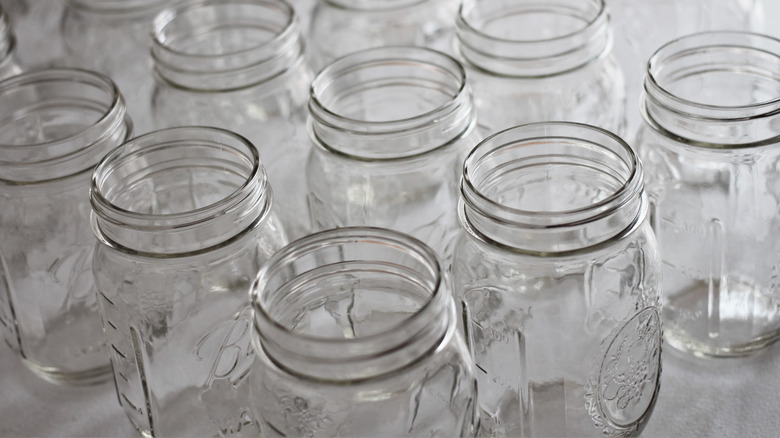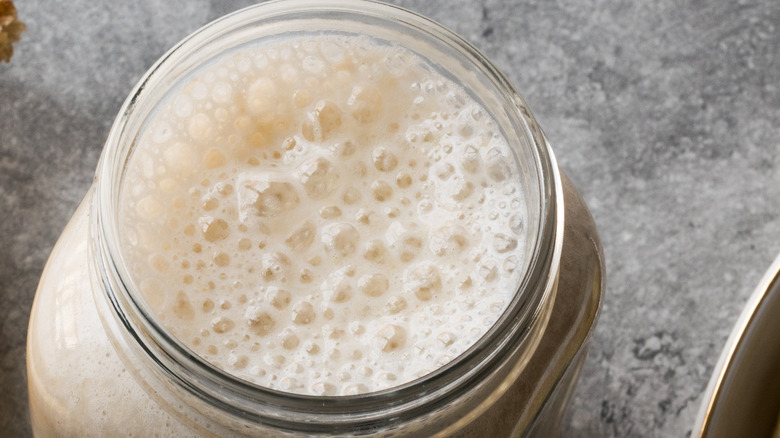The Mason Jar Baking Hack For When You Don't Have A Whisker
Every home should have mason jars — they're not just for the homestead, and certainly not just for canning! Although at-home food preservation is what they're best known for, they're generally a handy and low-tech thing to have around. These days, they also seem to be perpetually trendy, but they were once as crucial a kitchen tool as the stove and the skillet. According to Smithsonian Magazine, they were first conceptualized by John Landis Mason in the mid-1800s as he sought to streamline newfangled at-home canning, which back then was life-saving but unreliable. He patented jars with threads and screw-on tops with rubberized lids to keep air and water out. Since Mason delayed patenting the lids, they took off via other makers — and the rest is history.
The mason jar design hasn't had to change since its inventor's time. They're still thick glass jars that look rustic and serve many practical purposes. Ball, the manufacturer of the mason jar we all know and love, explains that their lids keep air out after canning, making them ideal for preserving certain foods without refrigeration. Smithsonian Magazine reminds us that during the height of the COVID-19 pandemic, mason jars were in high demand by gardeners seeking to save their harvest. But these simple, sturdy jars can also help in the kitchen in other ways.
Ball jars are a baker's best friend
One of the best reasons to keep a mason jar around is for making whipped cream. Unless you have a mixer to accomplish this, you must go through the hassle of hand-whisking, or settle for the store-bought stuff. King Arthur Baking Company's Kye Ameden writes that mason jar whipped cream works using the same agitation produced by a mixer, whisker, or spray can. Shaking it introduces more and more air, around which the fat molecules accumulate to produce a delicious foam, Ameden adds. Mason Jars suggests the addition of a flip-top cap and a wire mixing ball like what you'd see in a protein shake mixer bottle, but neither is necessary.
To make enough whipped cream to top a typical 9-inch pie, Ameden uses a cup of heavy cream (or whipping cream), 3 tablespoons of confectioner's sugar, and ¾ teaspoon of vanilla extract. Add all ingredients to a mason jar that's at least 12 ounces (pint-sized is fine) and agitate it for 60-90 seconds or until you achieve the desired texture. It's a good job to assign to a kid with a surplus of energy. For best results, Ameden urges us to use quality, high-fat cream and keep everything chilled until ready to serve.
Other culinary uses for mason jars
Whipped cream isn't the only thing you can make in a mason jar. Keep shaking milk long enough, and it will become butter. Yes, you read that correctly: the milk just has to become cream first. Cabot Creamery says to take a pint of heavy cream and shake it in a quart jar for around ten minutes or until the butter solids have settled with the buttermilk on top. Then, remove the buttermilk for other uses, like buttermilk fried chicken or apple-cinnamon buttermilk pancakes. Use the fresh butter as-is or knead it with salt and ice water before straining to firm it up, Cabot continues. You can also use canning jars to prepare homemade condiments: just combine your ingredients, screw on the lid, and shake it up. You can store the sauce in the same container when you're finished.
Mason jars are infinitely reusable and will last until you break them. Smithsonian explains that they became en vogue again as people gravitated toward the farmhouse chic aesthetic. On Ball's website, they provide instructions for several ways to can preserved food, as well as other fun uses like pantry spice organization, "cocktails in a jar," monogrammed glasses, and even personalized dog treat "recipes" for your favorite four-legged foodie. You can also use a large one as a vase for an edible bouquet at your next gathering.


